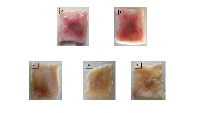Antivenom activity of ethanolic extract of Crescentia cujete fruit
Keywords:
Crescentia cujete fruit, Vipera russelli venom, antivenom, lethality, haemorrhagic lesion.Abstract
n almost every part of the world, where venomous snakes occur, numerous plant species are used as folk medicine to treat snake bite. Ayurveda states usage of specific plants against specific snake bite. Hence the present study was carried out to evaluate the antivenom activity of ethanolic extracts of Crescentia cujete fruit in experimental animals. The Crescentia cujete fruit was extracted using ethanol and tested for acute toxicity according to OECD 425 guidelines. The ethanolic extract of Crescentia cujete fruit at 100, 200 and 400 mg/kg were screened for the antivenom activity by in-vivo and in-vitro neutralizing capacity of lethality and neutralization of haemorrhagic lesion. The fruit extract at dose levels of 200 and 400 mg/kg effectively inhibited Vipera russelli venom induced in-vitro lethality with 83.33% and 100% survival rate against 2LD50 respectively. The survival rate remains 50% and 83.33% with 200 and 400 mg/kg doses respectively against 3LD50. Whereas dose of 400 mg/kg significantly inhibit venom induced in-vivo lethality with 66% and 50% survival rate against 2LD50 and 3LD50 respectively. Haemorrhagic lesion was neutralizing at both dose levels with highly significant at 200 mg/kg dose. Hence the present findings suggest that ethanolic extract of Crescentia cujete fruit possesses significant neutralizing capacity of snake Vipera russelli venom which may be beneficial in the treatment of snake bite. Further study on isolation of active constituent from this plant extract is needed for development of new chemical antidote for snake envenomation.
References
. Owuor BO, Kisangau DP. Kenyan
medicinal plants used as antivenin: a
comparison of plant usage. J
Ethnobiol Ethnomed. 2006;2:1-12.
. Meenatchisundaram S, Michael A.
Snake bite and therapeutic measures:
Indian scenario. Ind J Scie Techn.
;2(10):69-73.
. Pillay VV, Comprehensive Med.
Toxicology, 2nd ed. India: Paras
Medical Publishers; 2008. p. 966-94.
. Joseph K. Snakes, Venom and Snake
bite. Available from: URL:
http://www.physicianbyte.com/SnakeVe
nom.aspx.
. Gomes A, Das R, Sarkhel S, Mishra R,
Mukharjee S, Bhattacharya S, et al.
Herbs and herbal constituents active
against snake bite. Indian J Exp Biol.
;48:865-78.
. Kirthikar KR, Basu BD. In: Blatter E,
Caius JF, Mhaskar KS, editors. Indian
medicinal plants, 2nd ed., India:
International Book Distributors. 2008;3.
p. 1852-53.
. Calabash tree (Crescentia cujete).
Available from: URL:
http://www.inriodulce.com/links/carvedc
alabash.html
. Heltzel CE, Gunatilaka AAL, Glass TE,
Kingston DGI.
Furofuranonaphthoquinones: bioactive
compounds with a novel fused ring
system from Crescentia cujete.
Tetrahedron. 1993;49(31):6757–62.
. Mahbub KR, Hoq MM, Ahmed MM,
Sarker A. In vitro antibacterial activity of
Crescentia cujete and Moringa oleifera.
Bangladesh Res Pub J. 2011:5(4);337-
. Kokate CK, Purohit PA, Gokhale SB.
Pharmacognosy. Analytical
pharmacognosy: a method of drug
evaluation. Pharmacognosy. 9th ed.
Pune: Nirali Prakashan; 1998. p. 92-3.
. OECD/OCDE. OECD guidelines for
testing of chemicals acute oral toxicityup and down procedure. 2001;425:1-
Available from: URL:
http://www.oecd.org/dataoecd/17/51/19
. Theakston RDG, Reid HA.
Development of simple standard assay
procedures for the characterization of
snake venoms. Bulletin of the world
health organization, world health
organization. 1983;61(6):949-56.
. Kondo H. Hemorrhagic Activity of Habu
snake venom. Jap J M Sci Biol.
;13:43-51.
. Ghosh MN. Fundamentals of
Experimental Pharmacology. 2nd ed.
Calcutta: Scientific Book Agency; 1984.
p. 153-7.



